Our verdict
Pros
- Grounded sole feels planted
- Stable and supportive build
- Great mix of outsole grip and give
- Comfortable step-in feel
- Accommodating fit and wide versions
- Excellent breathability for warm weather
Cons
- Heavier than average (especially for a speed shoe)
- Questionable durability
- Not propelling as promised
Audience verdict
Comparison
The most similar tennis shoes compared
+ + Add a shoe | |||||
|---|---|---|---|---|---|
| Audience score | 69 Decent! | 87 Great! | 62 Bad! | 82 Good! | |
| Price | £140 | £135 | £130 | £150 | |
| Shoe type | Clay Court | Clay Court | Hard Court | Clay Court | |
| Construction | - | Speed | Speed | Stability | |
| Breathability | Breathable | Moderate | Breathable | Moderate | |
| Weight lab | 13.5 oz / 383g | 10.8 oz / 306g | 13.8 oz / 390g | 13.3 oz / 378g | |
| Lightweight | ✗ | ✓ | ✗ | ✗ | |
| Drop lab | 7.7 mm | 8.2 mm | 8.4 mm | 12.4 mm | |
| Width / fit | Medium | Medium | Wide | Wide | |
| Toebox width | Medium | Medium | Wide | Medium | |
| Size | - | True to size | Slightly small | True to size | |
| Midsole softness | Balanced | Firm | Balanced | Balanced | |
| Stiffness | Stiff | Moderate | Stiff | Stiff | |
| Torsional rigidity | Stiff | Stiff | Stiff | Stiff | |
| Heel counter stiffness | Moderate | Stiff | Moderate | Moderate | |
| Midsole width - forefoot | Wide | Average | Wide | Average | |
| Midsole width - heel | Average | Narrow | Average | Very wide | |
| Outsole durability | Bad | Decent | Decent | Bad | |
| Heel padding durability | Decent | Good | Bad | Good | |
| Heel stack lab | 28.3 mm | 27.9 mm | 29.8 mm | 30.2 mm | |
| Forefoot | 20.6 mm | 19.7 mm | 21.4 mm | 17.8 mm | |
| Insole thickness | Average | Average | Average | Thick | |
| Removable insole | ✓ | ✓ | ✓ | ✓ | |
| Heel tab | None | Extended heel collar | None | Finger loop | |
| Toebox durability | Decent | Good | Decent | Good | |
| Outsole hardness | - | Soft | Hard | Soft | |
| Outsole thickness | Average | Thin | Average | Average | |
| Ranking | #37 Bottom 5% | #13 Top 34% | #39 Bottom 1% | #29 Bottom 25% | |
| Popularity | #39 Bottom 1% | #15 Top 39% | #36 Bottom 7% | #34 Bottom 12% |
Who should buy
Having weighed the pros and cons of the New Balance FuelCell 996 v6, we believe that it can make a great option for players in search of the following:
- a tennis shoe with a very rigid response that promotes stability and efficient energy transfer (no shifting or wobbling)
- a clay court shoe with a perfect balance of grip and give for sliding
- a shoe with an accommodating fit and wide width options

Who should NOT buy
The 996 v6 Clay was supposed to be a speedy shoe 'inspired by racing cars', but it happened to gain some extra weight along the way.
Thus, it got undercut by the ASICS Solution Speed 3 FF Clay, which not only proved to be a lighter racer but also more durable, more flexible, and better cushioned in the heel.
The all-court Wave Exceed Tour 6 from Mizuno also makes a much lighter alternative with better overall lab test results than the 996 v6.
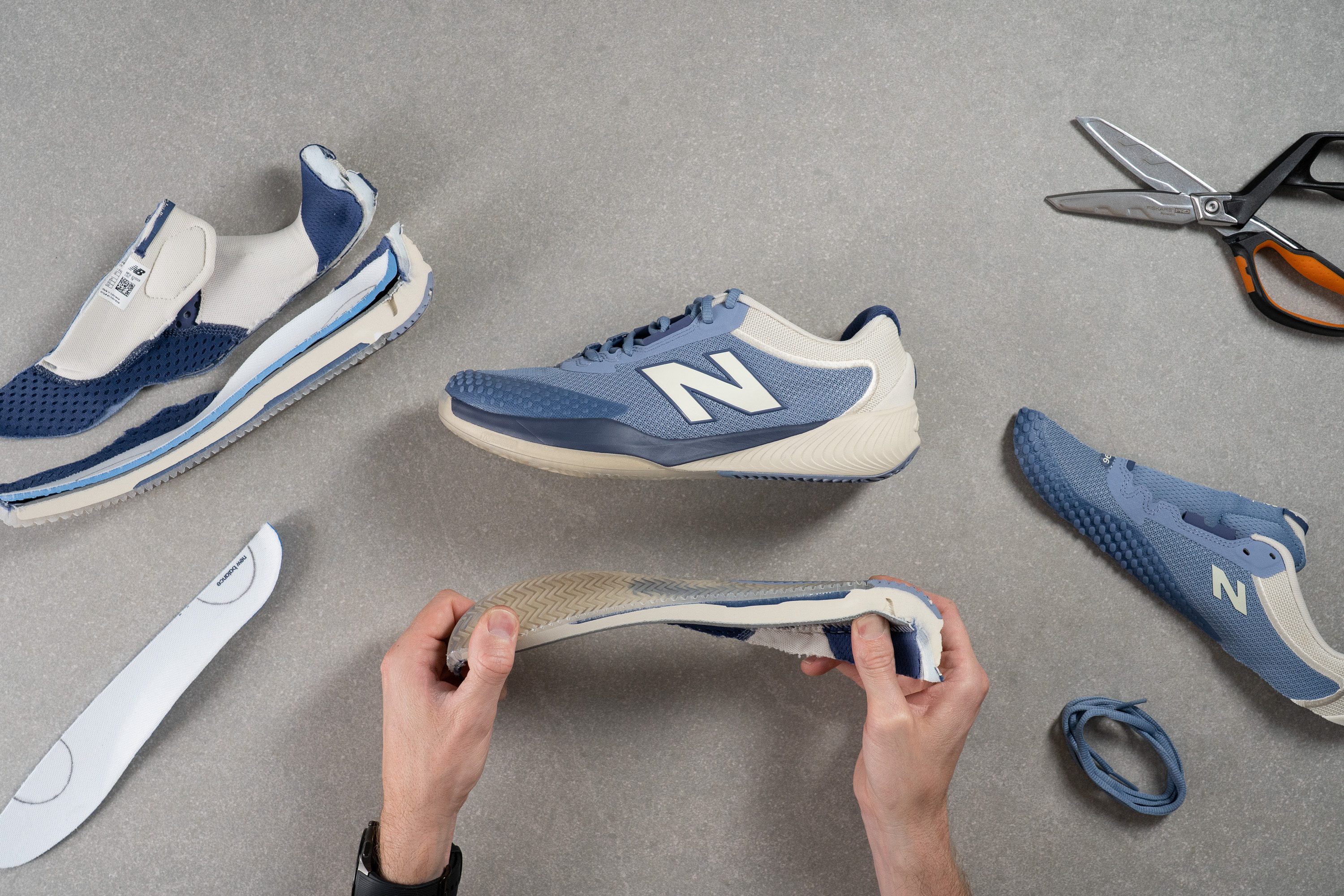
Cushioning
Shock absorption
The 996 v6's grounded profile becomes apparent from the very first step on the court.
Our shock absorption measurements confirmed that the shoe's impact protection is moderate at 99 SA in the heel and 70 SA in the forefoot. Both readings are standard for the tennis shoe category and can feel either sufficient or lacking, depending on the player's personal preferences and cushioning needs.
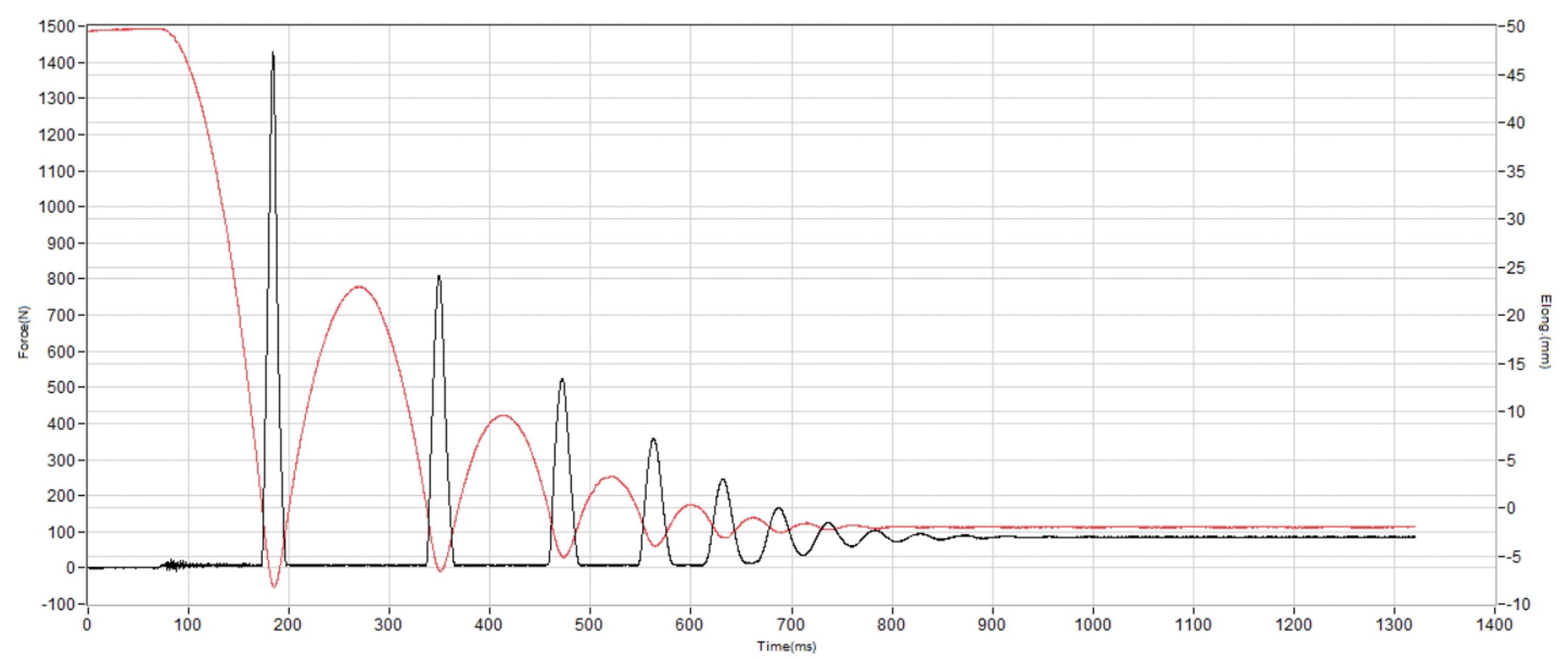
| FuelCell 996 v6 Clay | 99 SA |
| Average | 99 SA |
Energy return
The brand's product description sounds very promising, as it states that the shoe's FuelCell foam 'delivers a propulsive feel to drive you forward.'
But when we measured the exact amount of energy return that the 996 v6 Clay generates in the heel (50.4%) and in the forefoot (50.6%), we found that it is no different from most other tennis shoes in our catalogue.
While the shoe does feel responsive, it's not particularly propelling or explosive.
| FuelCell 996 v6 Clay | 50.4% |
| Average | 48.8% |
Heel stack
Measuring the heel stack of this New Balance shoe, we also got a fairly standard reading of 28.3 mm. It's neither too low to the court nor too high off the ground.
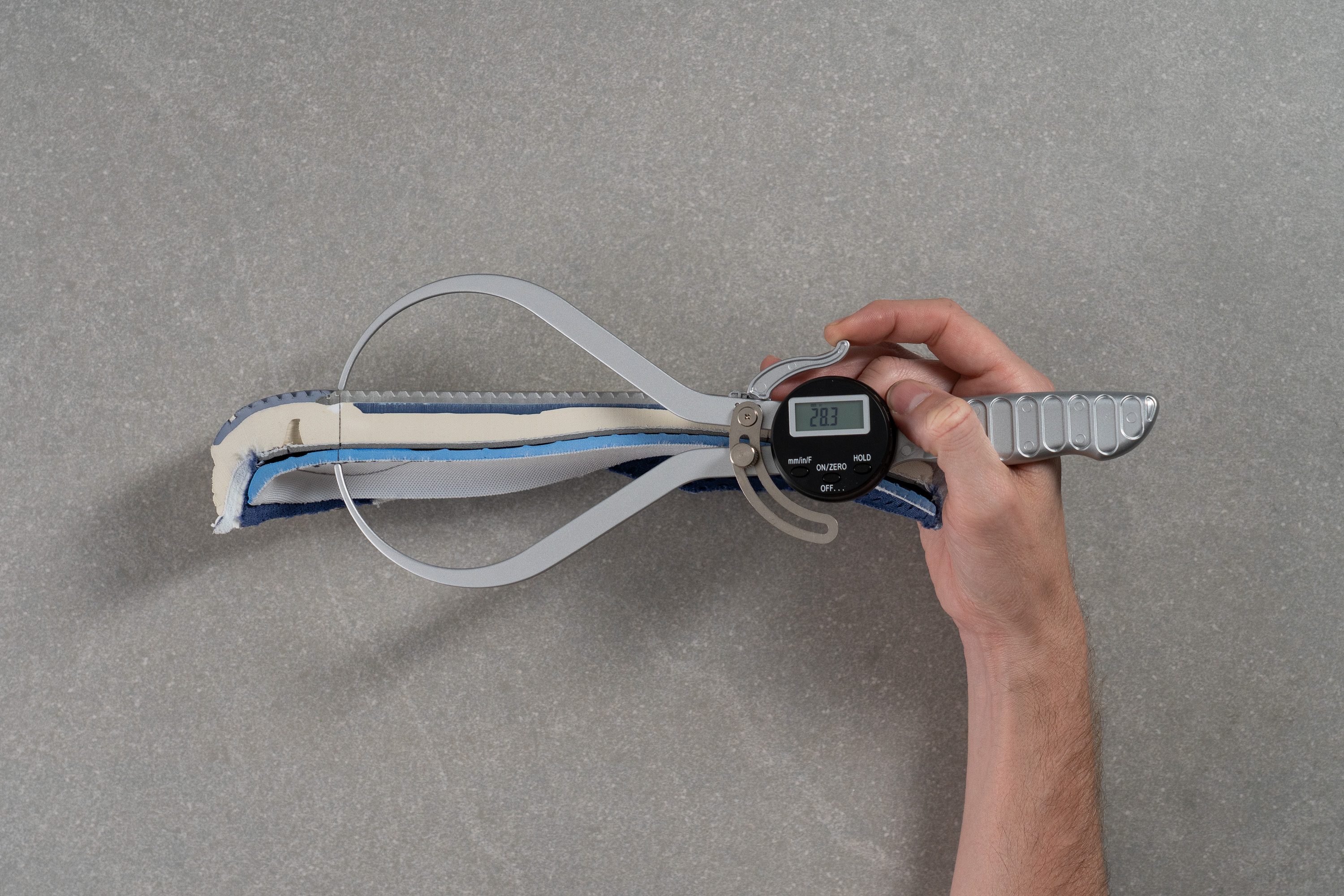
| FuelCell 996 v6 Clay | 28.3 mm |
| Average | 29.2 mm |
Forefoot stack
The shoe also provides a decent buffer for the ball of the foot and the toe joints with a forefoot stack height of 20.6 mm.
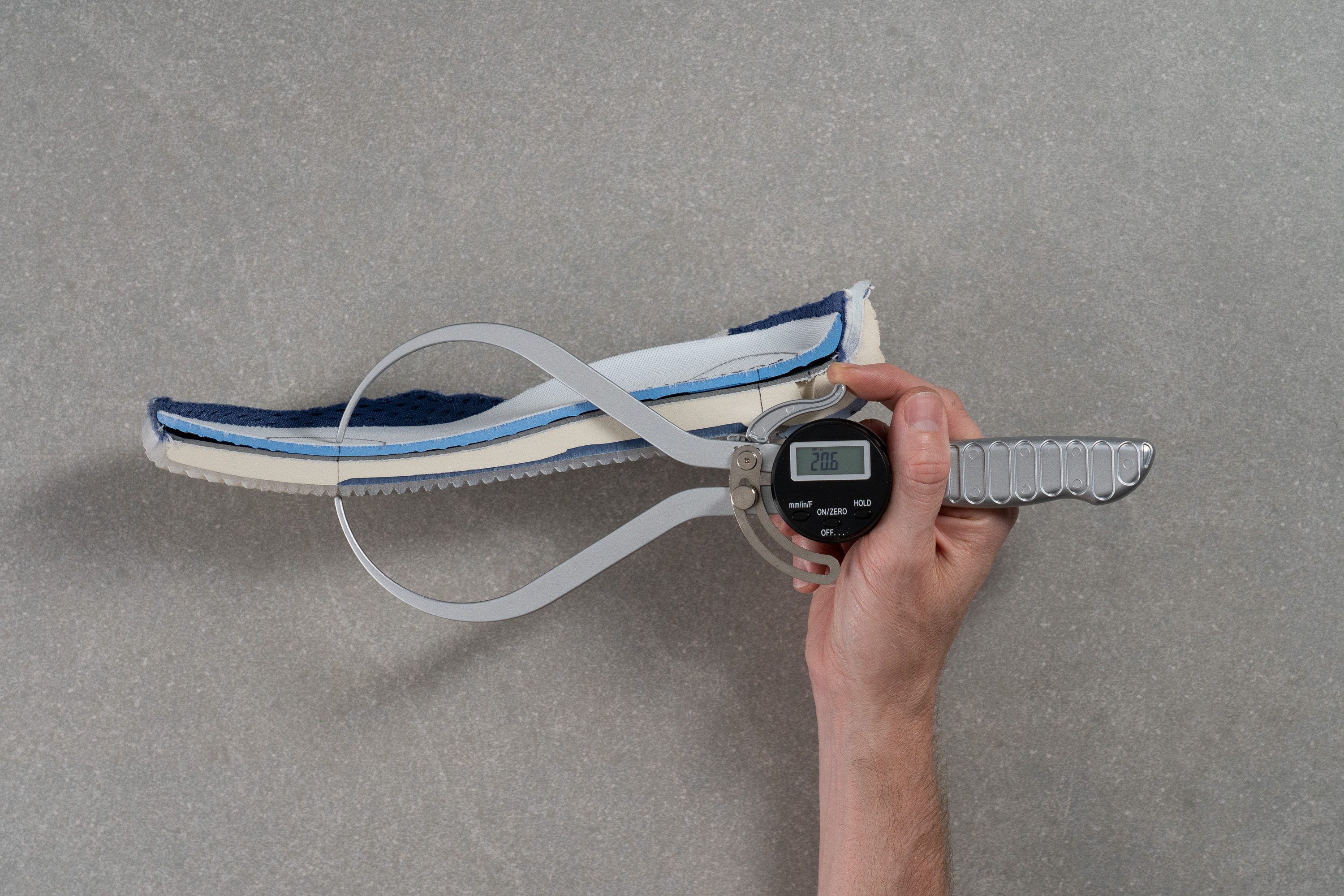
| FuelCell 996 v6 Clay | 20.6 mm |
| Average | 19.5 mm |
Drop
The heel-to-toe drop of the NB 996 v6 Clay feels pretty subtle at 7.7 mm. It offers a slight elevation in the rearfoot to cushion the heel and support the Achilles, while keeping the foot grounded enough for stability.
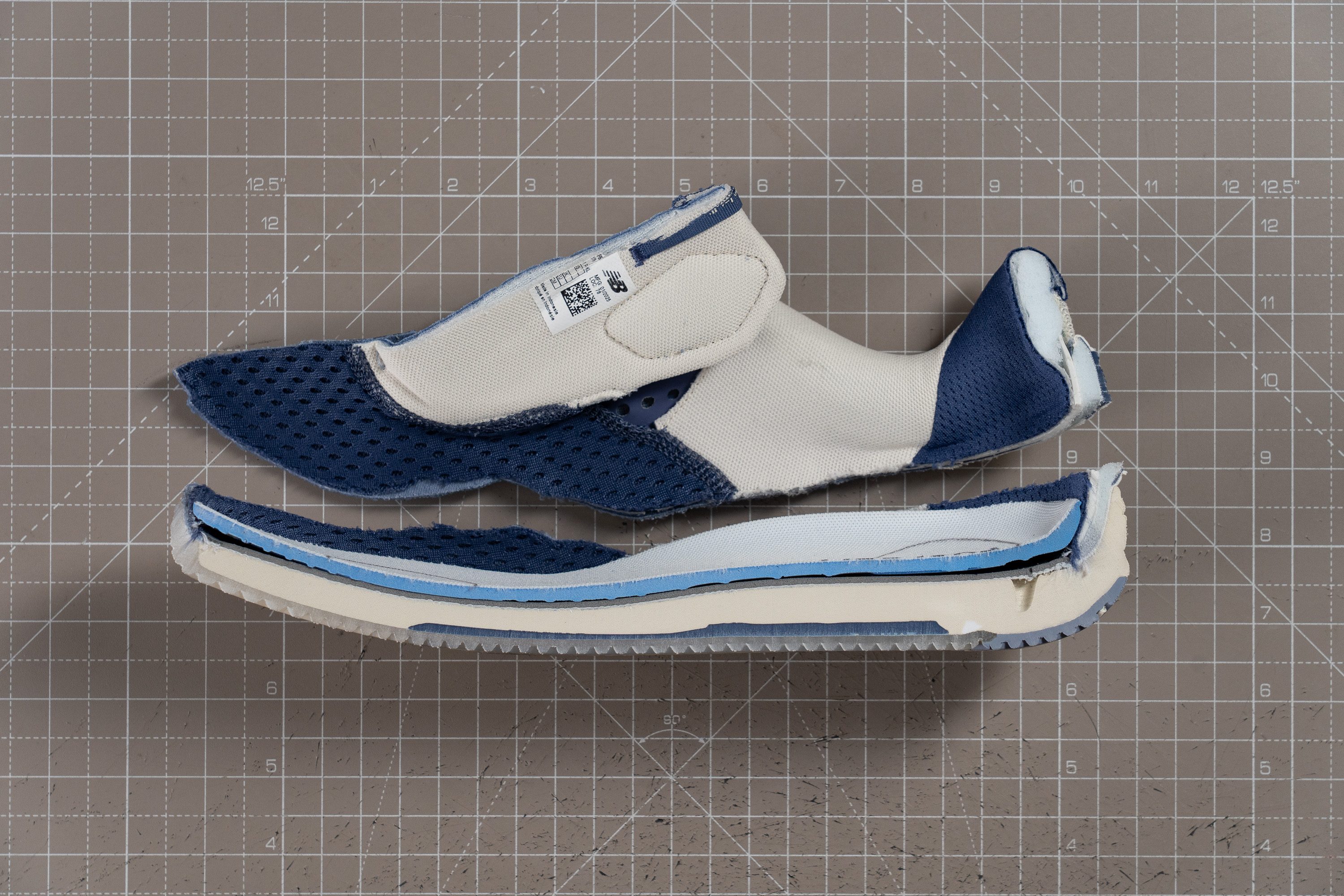
| FuelCell 996 v6 Clay | 7.7 mm |
| Average | 9.7 mm |
Midsole softness
The 996 v6 Clay employs a full-length FuelCell foam for primary cushioning.
It is a single-density component that proved to be moderately soft with a durometer reading of 22.0 HA. But please note that the large bottom-loaded shank beneath it makes the ride feel firmer.
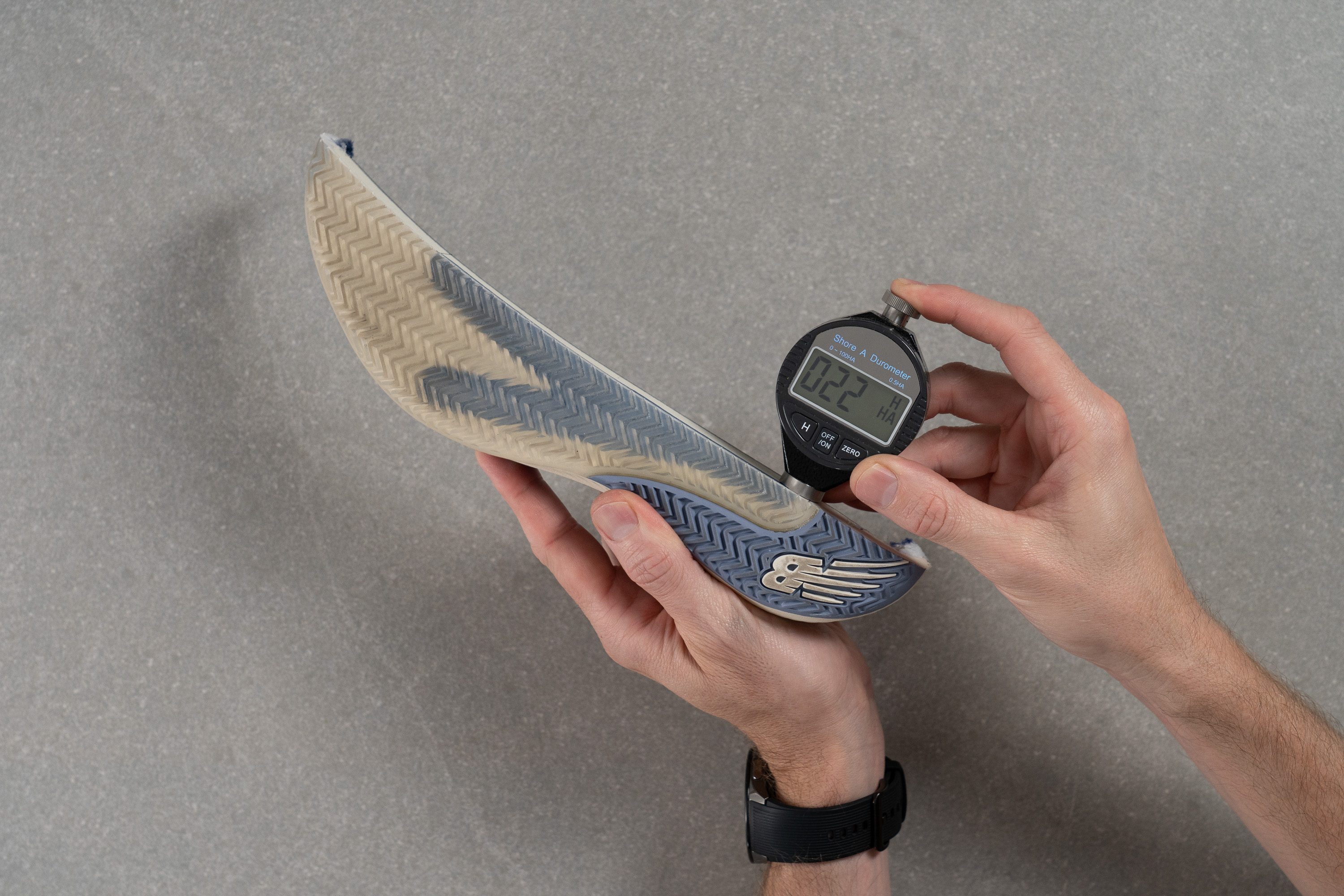
| FuelCell 996 v6 Clay | 22.0 HA |
| Average | 28.1 HA |
Size and fit
Size
Width / Fit
On the shoe's product page, New Balance warns buyers that the 996 v6 Clay 'runs narrow' and that they 'may prefer a wider width.' But is that so?
Having created a one-to-one gel mould of the shoe's interiors, we used a digital calliper to measure its forefoot dimensions more thoroughly.
The widest part of the mould (ball of foot area) returned 94.6 mm, which is, in fact, wider than average! Our medium-width feet didn't feel restricted in this NB shoe at all!
But if you do need a more accommodating fit, this model is also available in the wide (2E) variant.
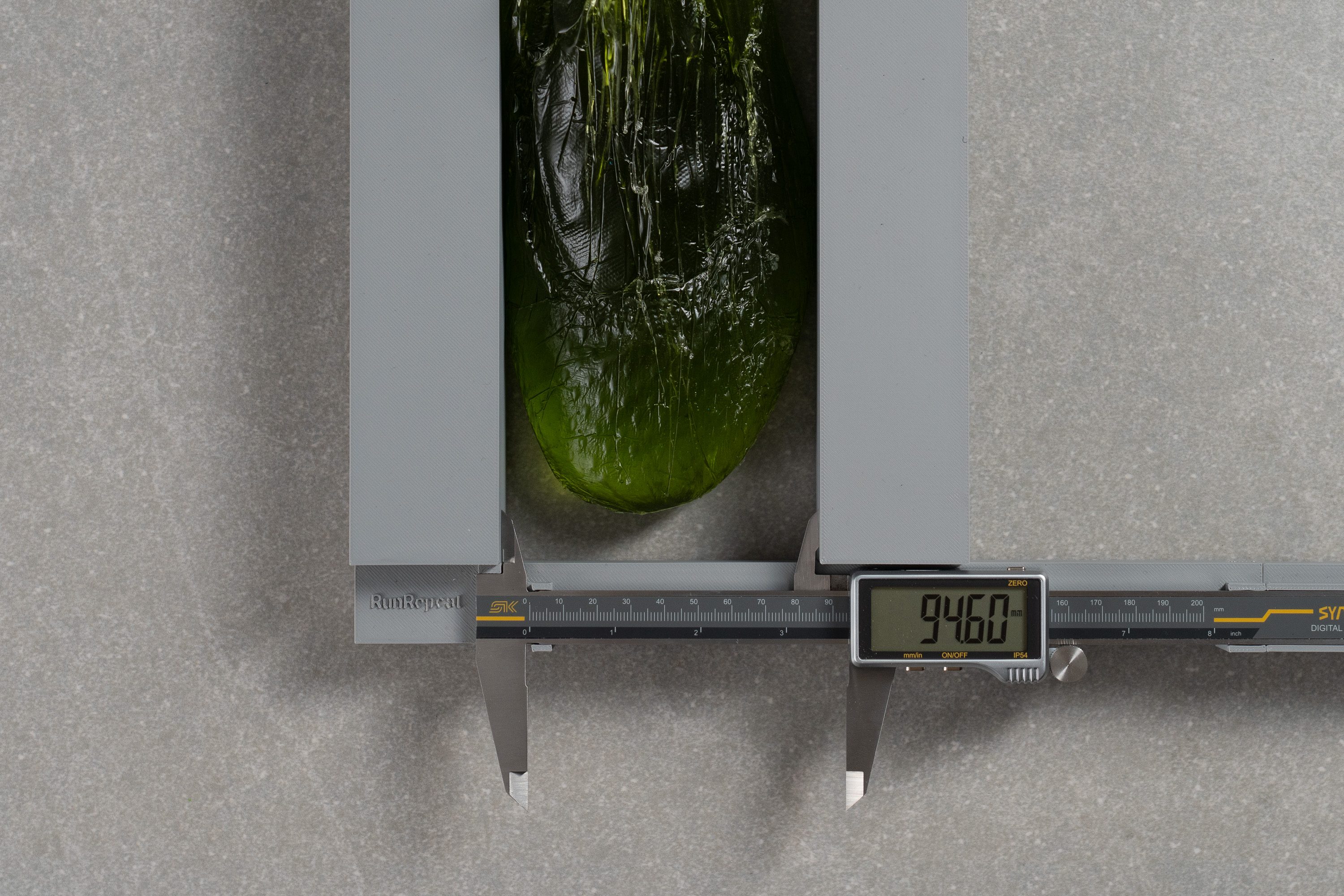
| FuelCell 996 v6 Clay | 94.6 mm |
| Average | 92.9 mm |
Toebox width
We cannot complain about any aggressive toebox tapering either.
The shoe's forefoot shape stays rounded towards the front, reflecting its roomy fit in an above-average width of 72.0 mm in the big toe area.
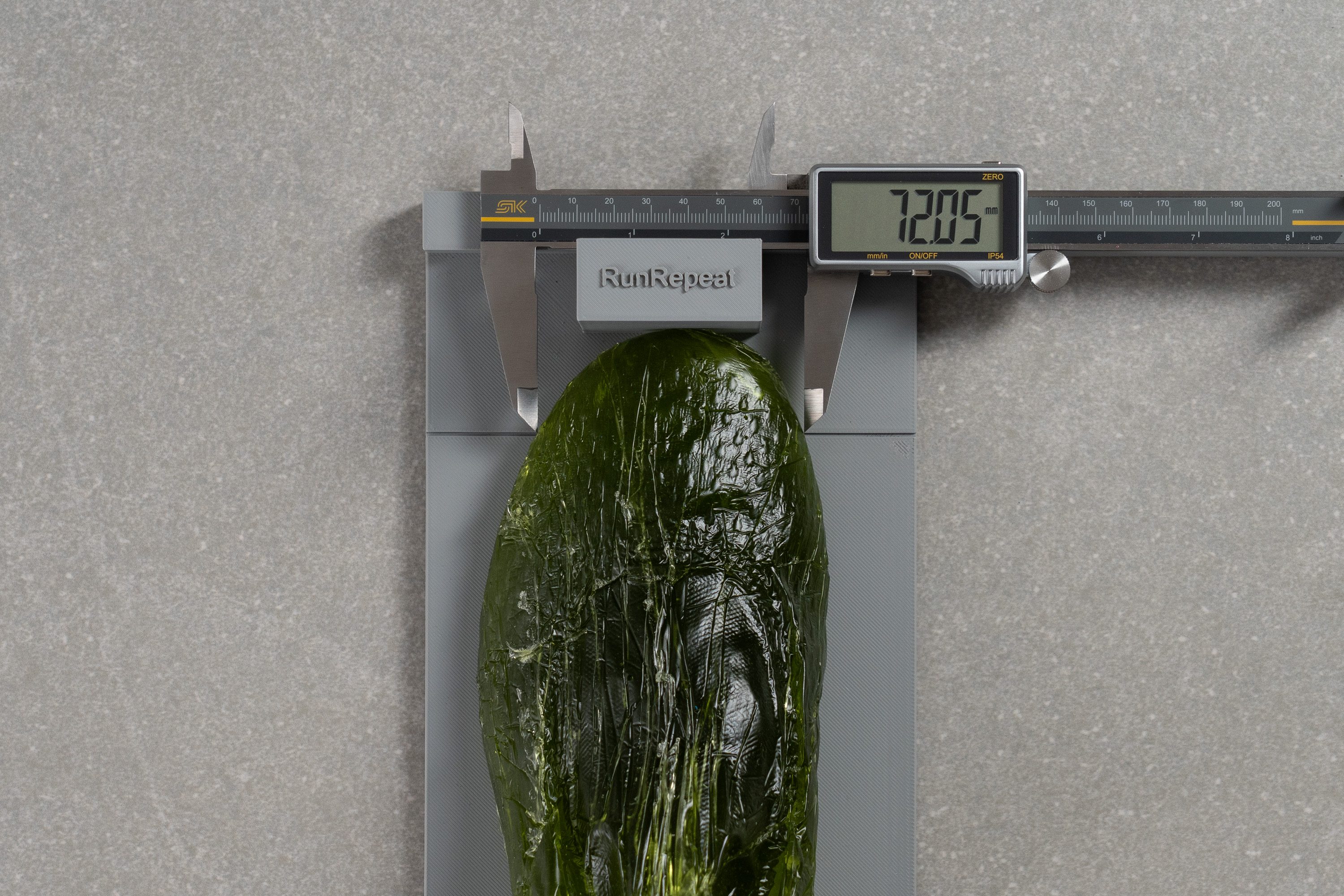
| FuelCell 996 v6 Clay | 72.0 mm |
| Average | 69.2 mm |
Toebox height
Lastly, the shoe's toebox height comes in at 23.1 mm, slightly below the average.
But even though the vertical space is slightly limited by the shoe's protective rubber overlay, it didn't feel uncomfortably restricting.
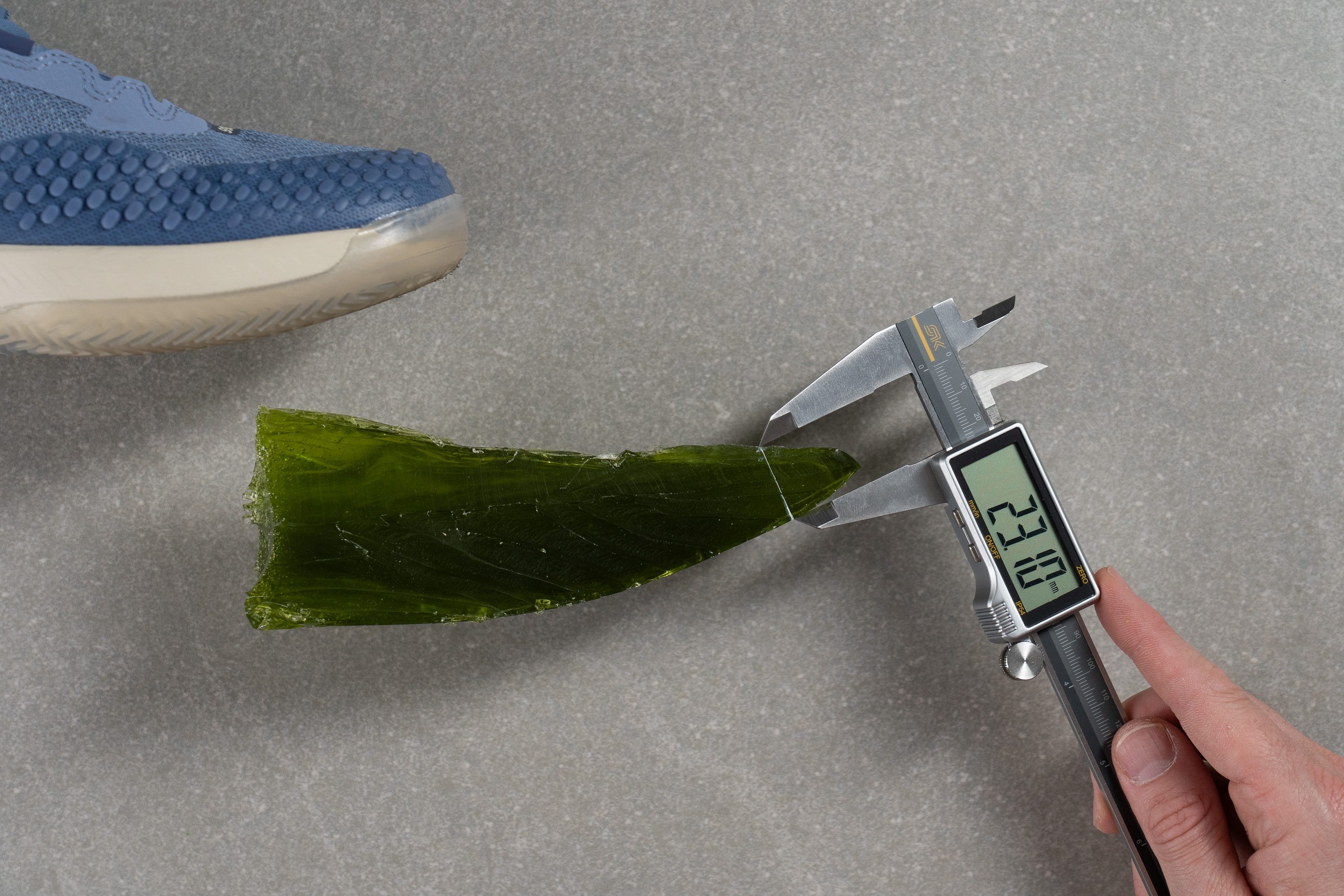
| FuelCell 996 v6 Clay | 23.1 mm |
| Average | 25.1 mm |
Traction / Grip
Forefoot traction
The clay court version of the 996 v6 offers a moderately tacky outsole rubber, which is ideal for this type of court.
With a friction coefficient of 0.57, this NB tennis shoe stops and controls the footing when necessary without hindering the fluidity of slides and toe drags.
| FuelCell 996 v6 Clay | 0.57 |
| Average | 0.76 |
Outsole design
The 996 v6 carries over the v5's outsole design and tread pattern with no tweaks or changes. But in this case, it is only reasonable given how perfectly functional it is.
Also note that the shoe features a non-marking outsole, so it can be used indoors as well.

Flexibility / Stiffness
The brand's description makes it sound like the FuelCell 996 v6 is a flexible shoe, but we found the complete opposite to be true!
Even though its chicken-foot shank doesn't stretch all the way to the forefoot, the shoe's raised midsole topline and protective overlays limit its pliability quite a bit! Our shoe stiffness tester showed that it took a whopping 24.5N to bend the 996 v6 by 30 degrees.
As one of the highest readings among our lab-tested tennis shoes, it can be a positive thing for players who prefer a more rigid response for better energy transfer through their shoes. But it can also backfire for athletes who value more freedom of movement and manoeuvrability in the forefoot.

| FuelCell 996 v6 Clay | 24.5N |
| Average | 16.6N |
Weight
The 996 v6 Clay is marketed as a tennis shoe that's built for speed, but our scale numbers tell a different story.
Weighing the shoe in a men's US size 9, we recorded a hefty reading of 13.5 oz (383g). This is heavier than the category average and even heavier than the stability-packed ASICS Gel Resolution 9 Clay (13.0 oz/369g)!
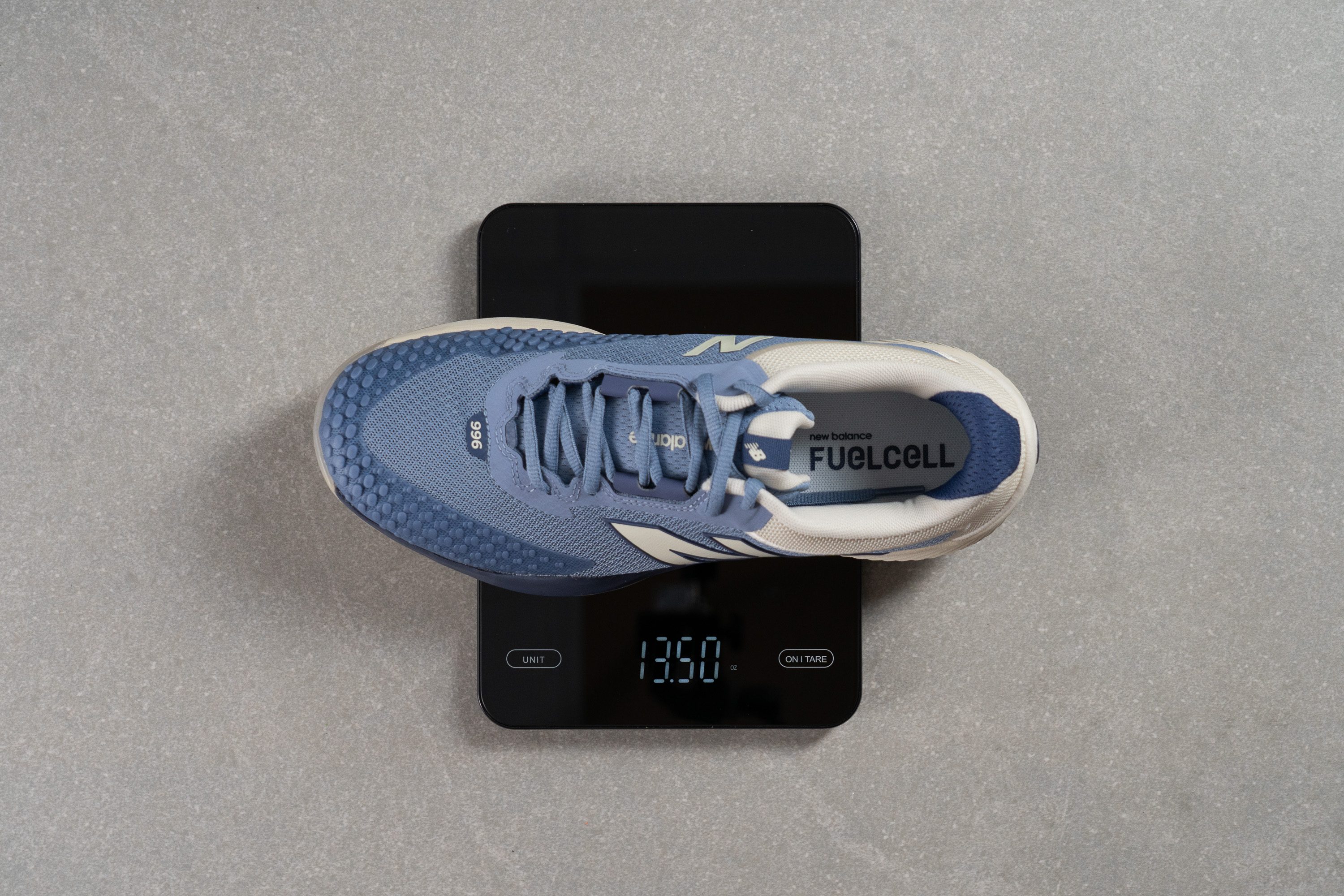
| FuelCell 996 v6 Clay | 13.5 oz (383g) |
| Average | 12.8 oz (362g) |
Breathability
Fortunately, one characteristic from the 996 v6 Clay's description did get backed up by our lab tests.
Assessing the size and density of billows passing through the shoe's toebox in our smoke-pumping machine test, we readily gave the shoe a high breathability score of 4 out of 5!
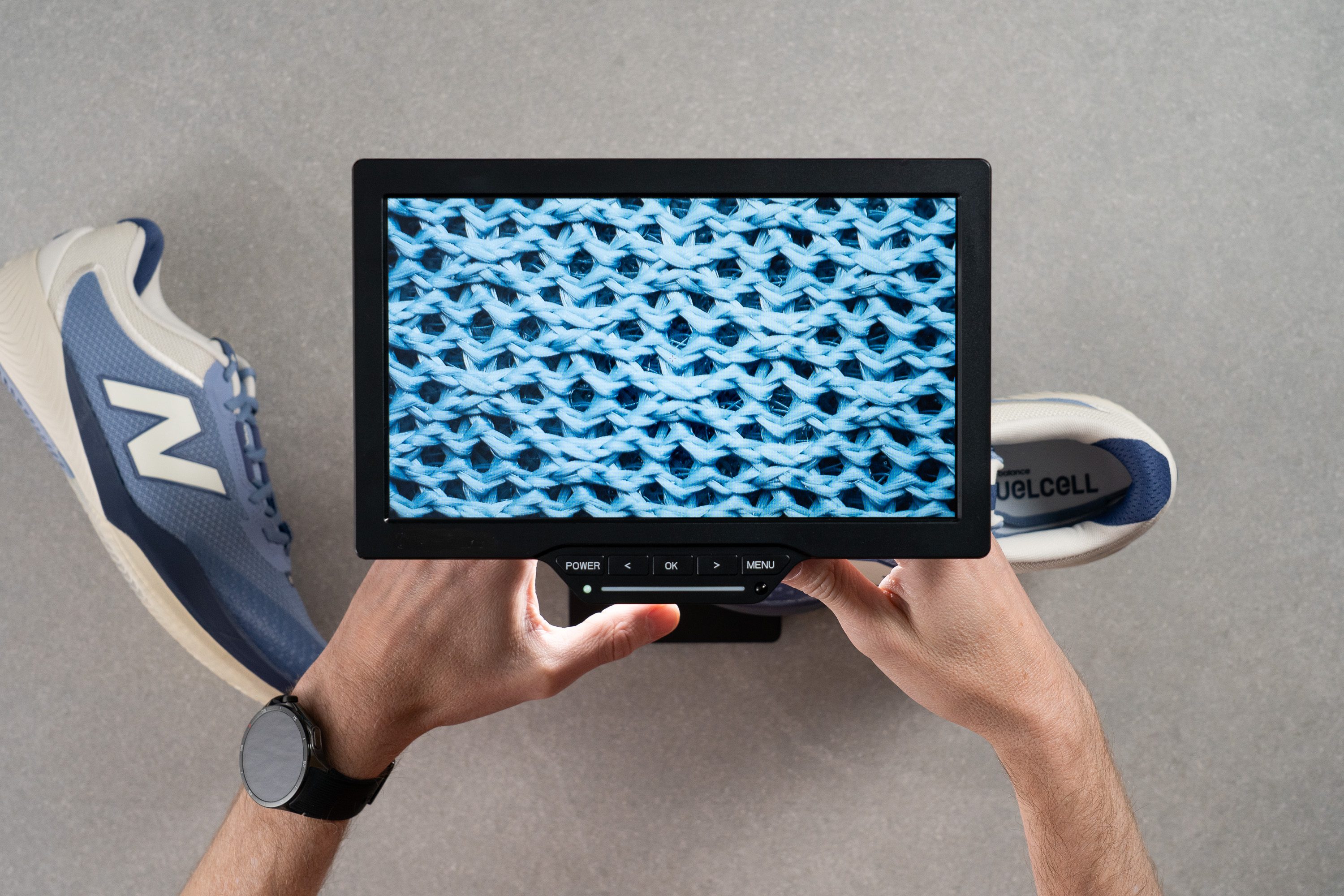
Taking a closer look at the shoe's mesh through the lens of our microscope, we could see how wide open its pores are.
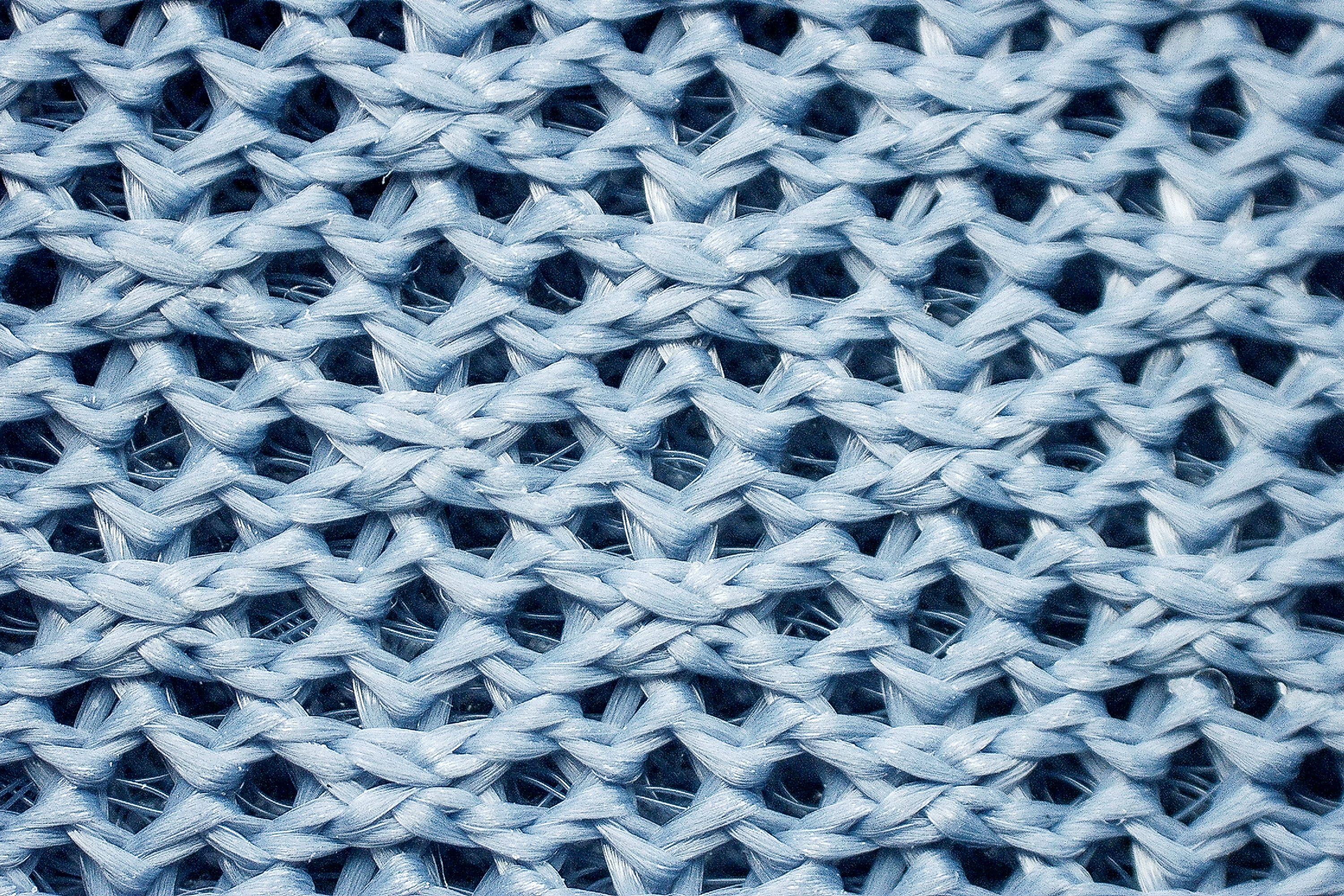
And as our transparency test confirmed, this well-ventilated fabric stretches to cover the 996 v6's toebox, vamp, and quarters, spreading the airflow all throughout the shoe.
It is surely ready for longer sessions in hot weather!
| FuelCell 996 v6 Clay | 4 |
| Average | 3.2 |
Stability
Lateral stability test
Very often, oddly-looking shoe features turn out to be gimmicky and merely decorative, but this is not the case with the NB 996 v6 Clay's chicken foot torsion system!

It is a long, three-point, and bottom-loaded shank that helps to plant the foot very firmly and surefootedly in the court.
It works together with the other components, like raised midsole sidewalls, to create a highly supportive platform for quick and forceful side-to-side movements.
Torsional rigidity
No wonder this New Balance shoe proved to be impossible to twist in our manual test!
The aforementioned tandem of stabilising features raises the 996 v6 Clay's torsional rigidity high above the average to a maximum stiffness score of 5/5!
| FuelCell 996 v6 Clay | 5 |
| Average | 4.4 |
Heel counter stiffness
A higher collar with improved heel lockdown is listed as one of the shoe's major updates.
As you can see from the side-by-side comparison below, the collar line rises slightly higher in the v6, indeed. And there is a new sturdy overlay embracing the heel, too.
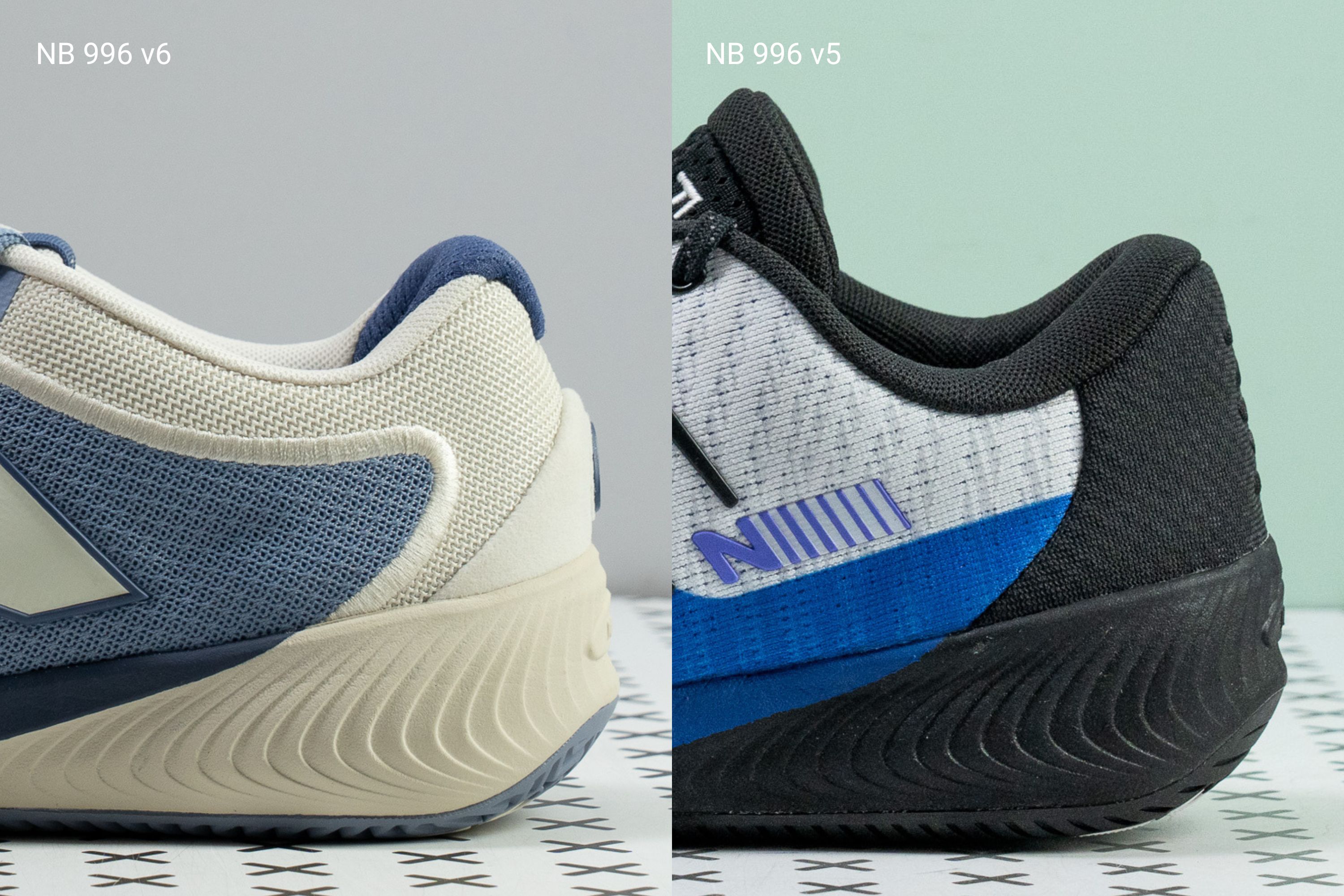
We can also confirm that the v6's heel collar got notably stiffer as we had to apply more pressure to push and squeeze it in our manual test. This increased our heel counter stiffness score from 3 to 4 in the 996 v6.
This helped to minimise heel shifting and slippage inside the shoe, particularly during hard stops and lateral cuts.
| FuelCell 996 v6 Clay | 4 |
| Average | 4.1 |
Midsole width - forefoot
The shoe's midsole protrudes on both sides of the forefoot, forming a highly stable and reliable outrigger to lean on.
Measuring its width in the broadest area, our calliper returned an above-average reading of 115.6 mm.
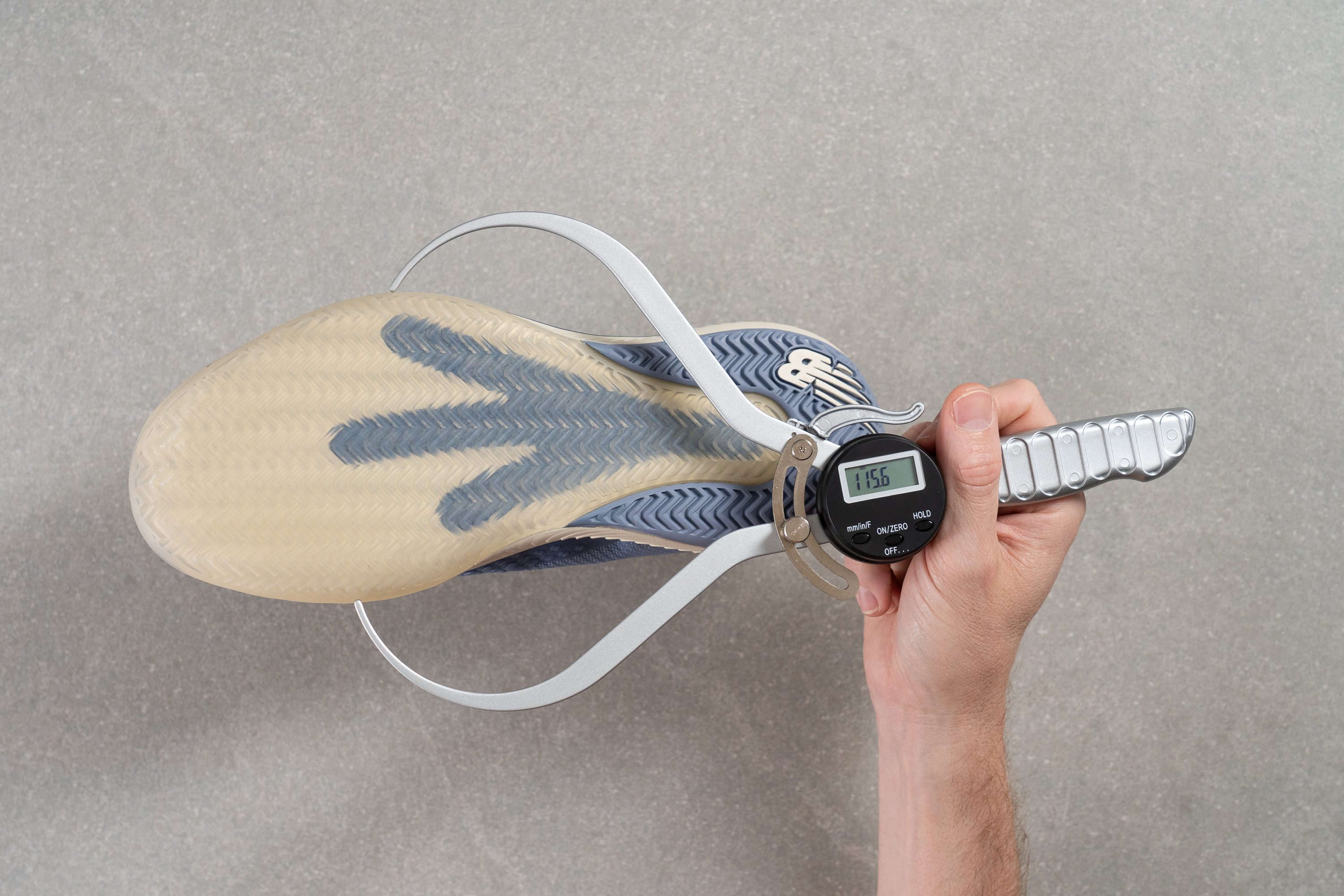
| FuelCell 996 v6 Clay | 115.6 mm |
| Average | 111.9 mm |
Midsole width - heel
Although not particularly wide, the shoe's heel turned out to be sufficiently broad to support surefooted steps at 86.8 mm.
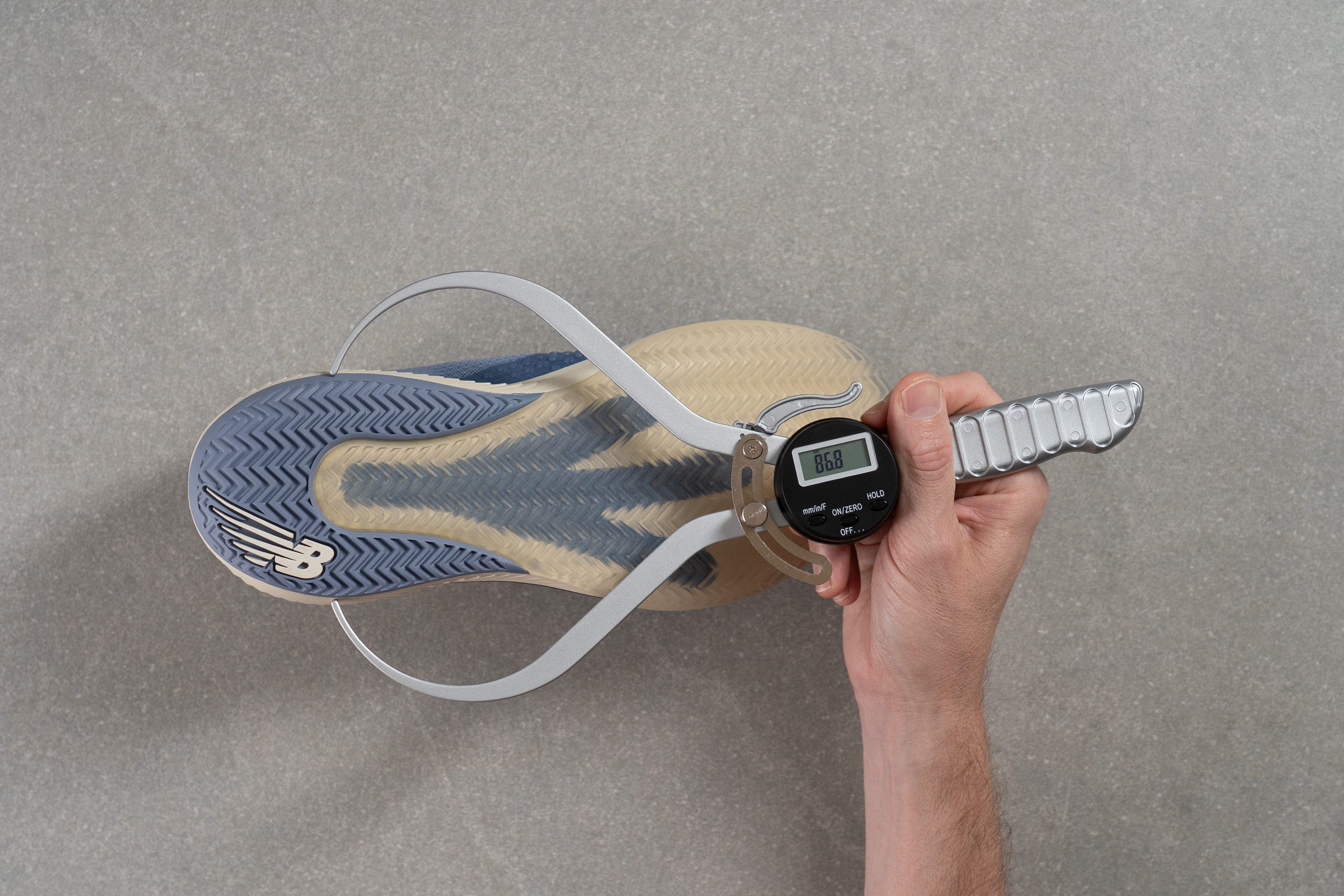
| FuelCell 996 v6 Clay | 86.8 mm |
| Average | 89.6 mm |
Durability
Toe guard durability
The bumpy texture of the shoe's protective toebox overlay may seem like it's ready for toe drags, but to our great disappointment, it was destroyed in just a few seconds of our Dremel test! Not even a hint of resistance from that rubber!
We didn't expect such poor durability from a clay court shoe and couldn't rate the 996 v6 Clay's toe drag guard durability any higher than the lowest score of 1/5.
| FuelCell 996 v6 Clay | 1 |
| Average | 3.3 |
Toebox durability
In return, we were utterly surprised by how hard-wearing the shoe's mesh textile is. Especially in contrast with the rubber overlay.
The Dremel only burned through the fabric's topmost layer, leaving some notable scuffing but no see-through hole. That bumped up the 996 v6's toebox durability to 3/5.
| FuelCell 996 v6 Clay | 3 |
| Average | 3.7 |
Heel padding durability
The shoe's heel collar also sustained some chafing, but not to a critical extent. Moderately wear-resistant, it earned a middle-ground durability score of 3/5 as well.
| FuelCell 996 v6 Clay | 3 |
| Average | 3.3 |
Outsole durability
Last but not least, we applied our Dremel to the shoe's outsole, hoping for good news from the New Balance NDurance rubber.
With a dent of 1.1 mm, it wasn't the best result for a tennis shoe, but not a disappointing one either.
| FuelCell 996 v6 Clay | 1.1 mm |
| Average | 0.8 mm |
Outsole thickness
The thickness of its outsole also gives some confidence with a standard calliper reading of 4.1 mm.
We are not as concerned about the 996 v6 Clay's outsole durability as we are about its vulnerable upper materials.

| FuelCell 996 v6 Clay | 4.1 mm |
| Average | 4.2 mm |
Misc
Insole thickness
A major part of the 996 v6 Clay's step-in comfort is played by its well-padded insole. It showed a solid thickness of 4.5 mm on our calliper.
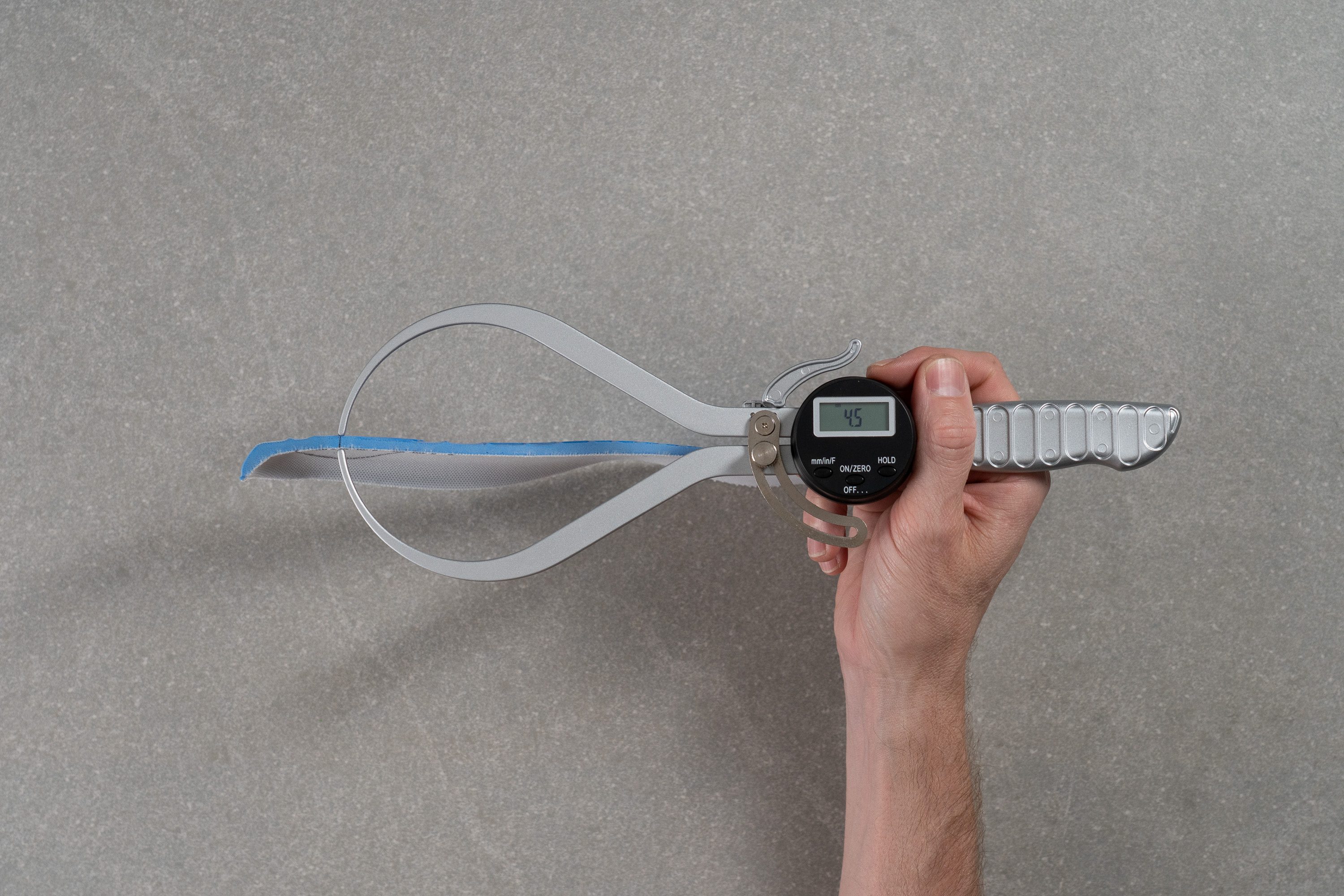
| FuelCell 996 v6 Clay | 4.5 mm |
| Average | 5.1 mm |
Removable insole
The insole has a synthetic coating, making it easy to take out and replace if needed.
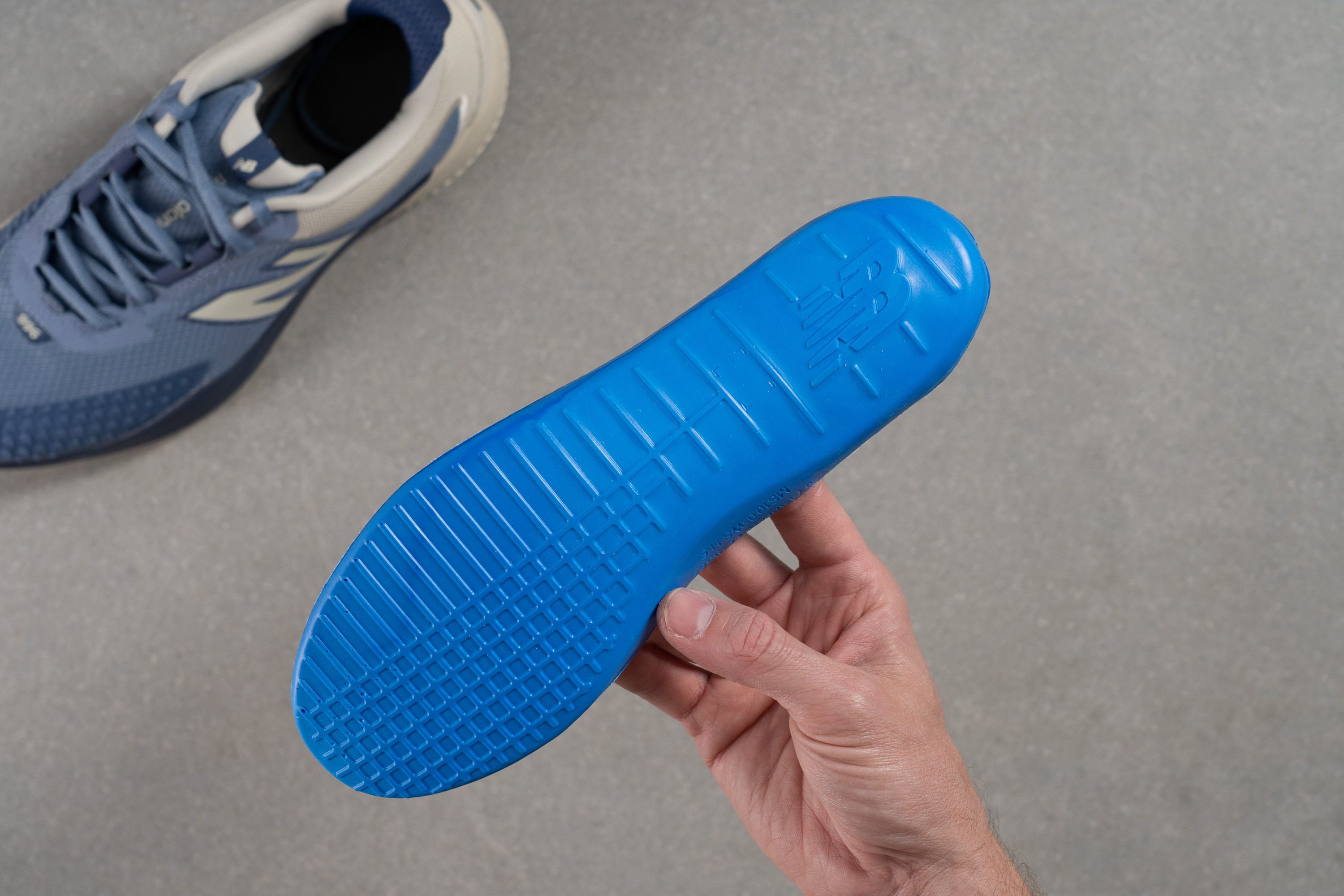
| FuelCell 996 v6 Clay | Yes |
Tongue padding
Examining the inner side of the 996 v6's upper, we found it to be minimally padded in both the tongue and the collar.
Our calliper measured its tongue thickness at a below-average reading of 5.4 mm.
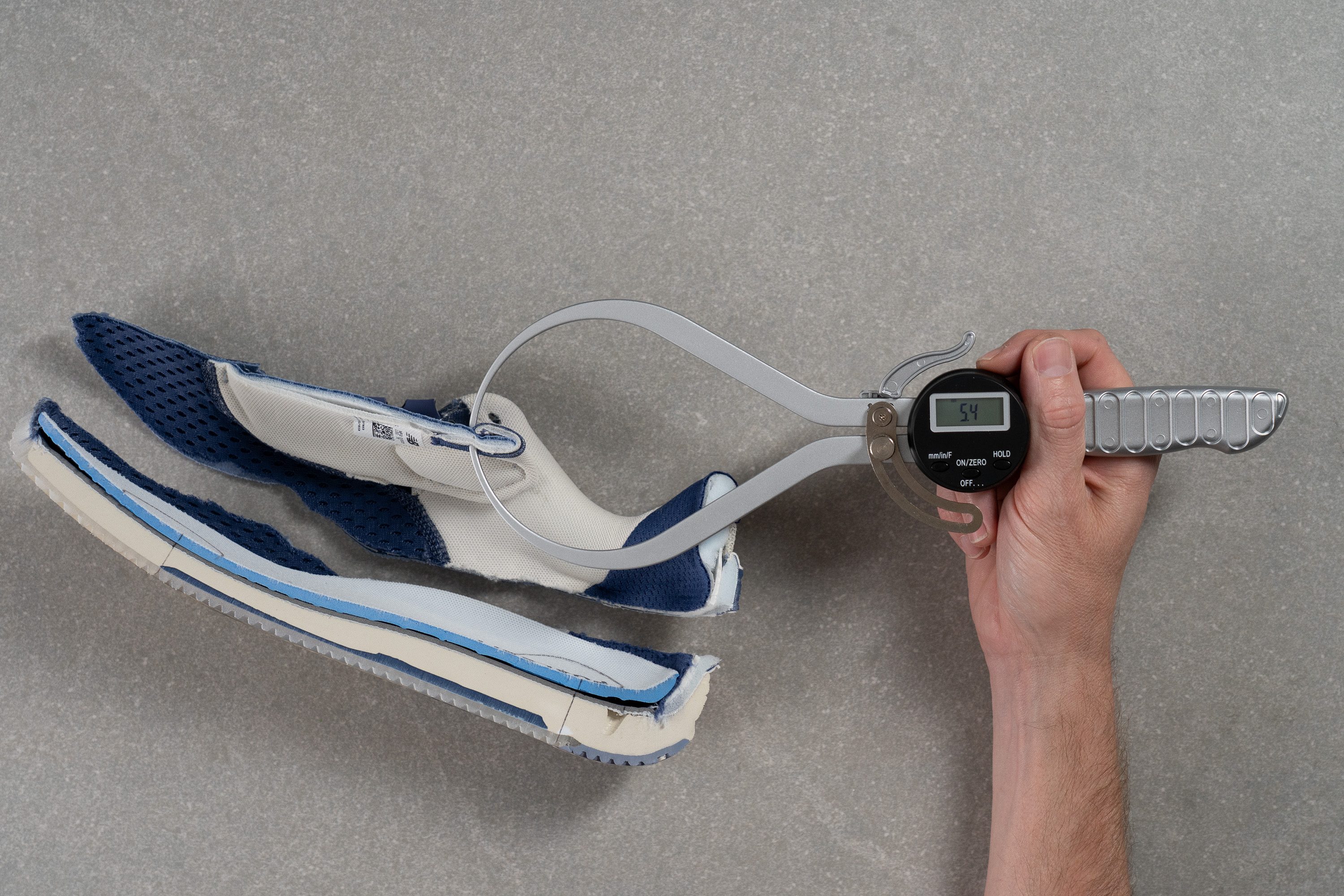
| FuelCell 996 v6 Clay | 5.4 mm |
| Average | 8.1 mm |
Tongue: gusset type
A fully gusseted tongue works together with the shoe's stiff heel counter to lock the foot in securely for dynamic movements.
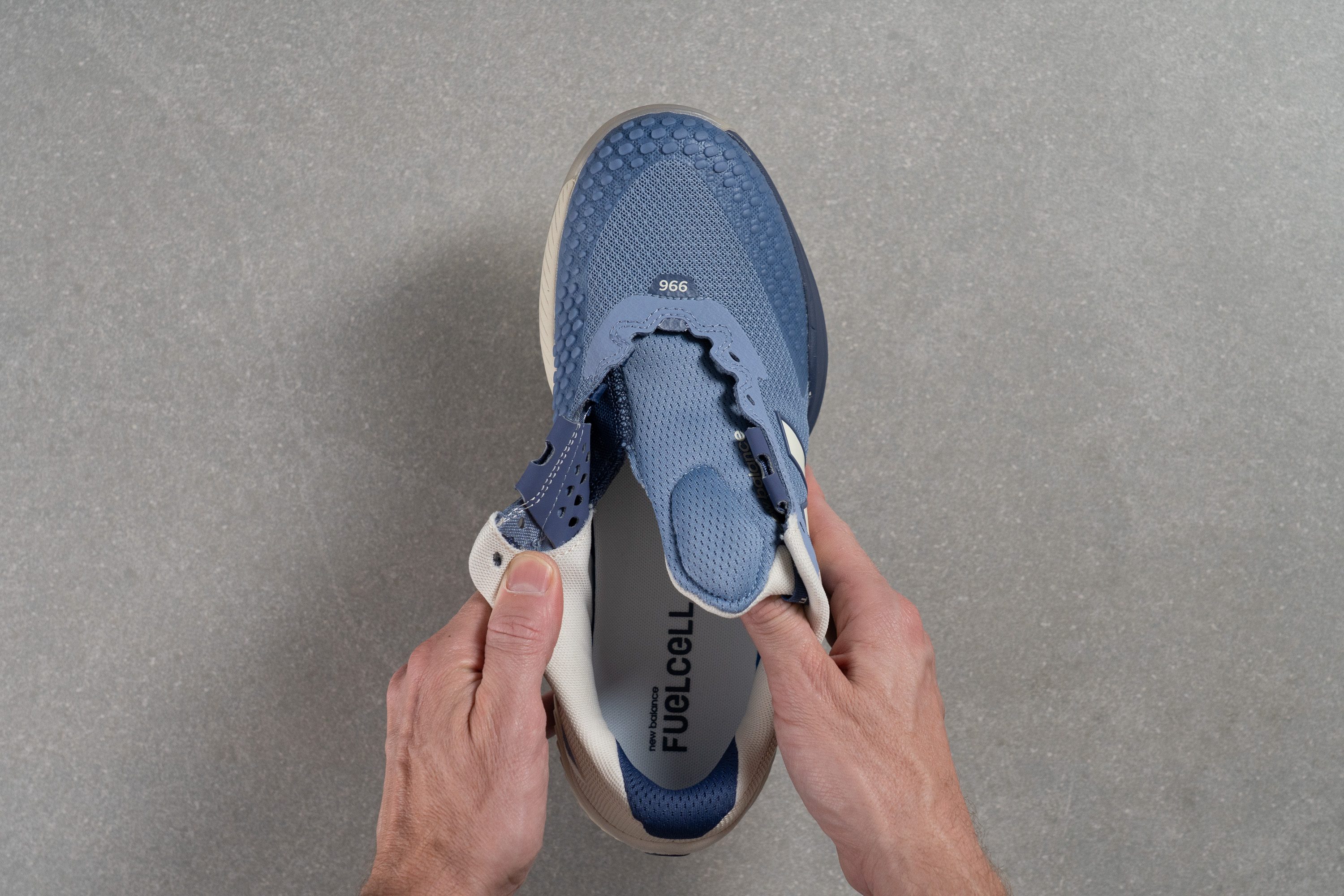
| FuelCell 996 v6 Clay | Both sides (full) |
Price
The New Balance FuelCell 996 v6 Clay finds itself in the same price range as the other highly regarded speed tennis shoes, like the ASICS Solution Speed FF 3 Clay.
However, its heavier weight and questionable durability make it feel inferior to similar options from the other brands.
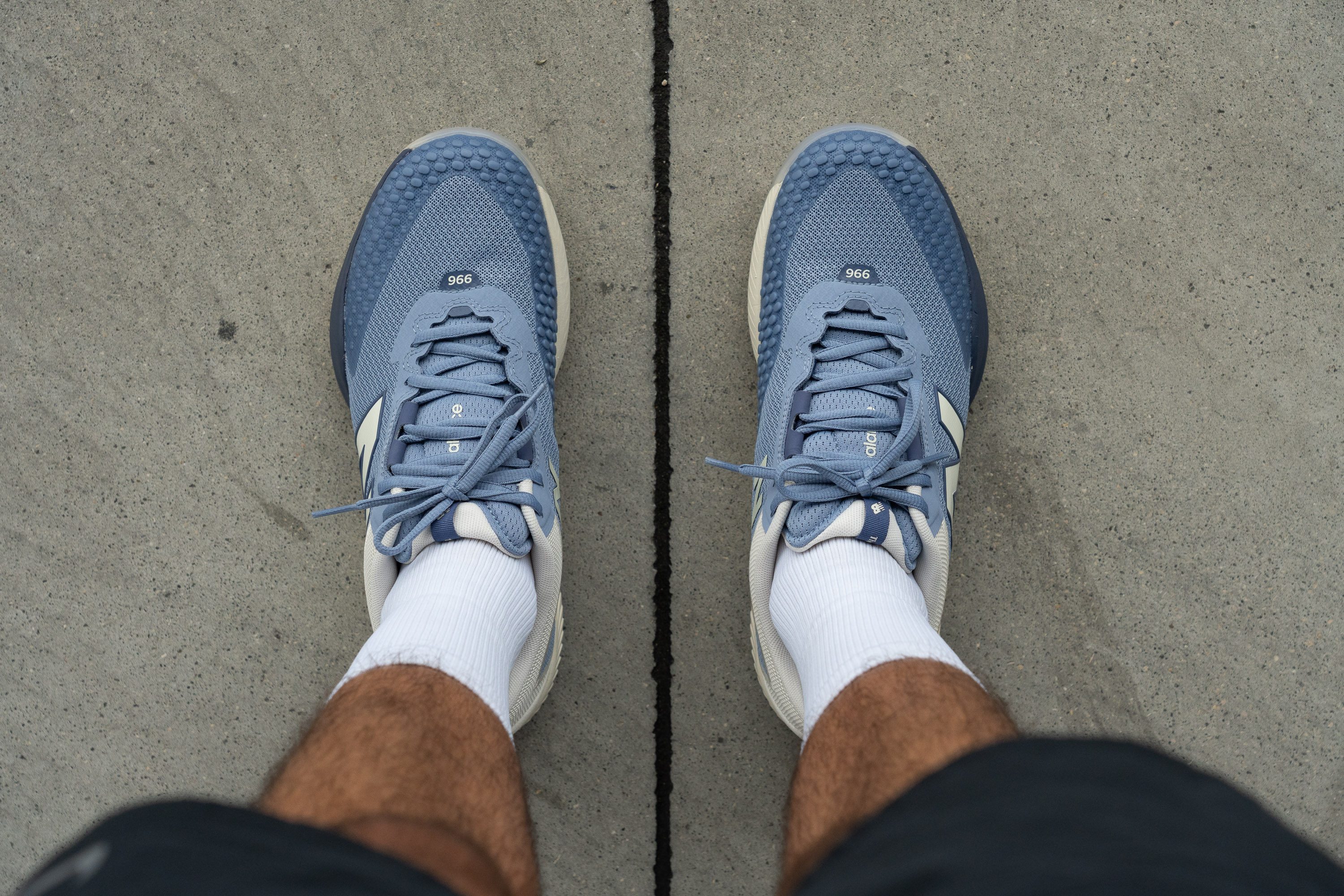
| FuelCell 996 v6 Clay | $135 |
Heel tab
There are no finger loops or pull tabs on this New Balance shoe.

| FuelCell 996 v6 Clay | None |



















































